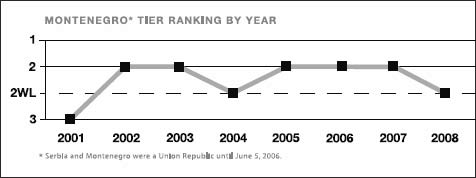Trafficking in Persons Report 2008 - Montenegro
| Publisher | United States Department of State |
| Author | Office to Monitor and Combat Trafficking in Persons |
| Publication Date | 4 June 2008 |
| Cite as | United States Department of State, Trafficking in Persons Report 2008 - Montenegro, 4 June 2008, available at: https://www.refworld.org/docid/484f9a2d37.html [accessed 6 June 2023] |
| Disclaimer | This is not a UNHCR publication. UNHCR is not responsible for, nor does it necessarily endorse, its content. Any views expressed are solely those of the author or publisher and do not necessarily reflect those of UNHCR, the United Nations or its Member States. |
MONTENEGRO (Tier 2 Watch List)
Montenegro is primarily a transit country for the trafficking of women and girls to Western Europe for the purpose of commercial sexual exploitation. In 2007, there were no reports of Montenegrins being trafficked to other countries. There were a small number of cases in which women and girls were trafficked into Montenegro. Women and girls from Serbia, Kosovo, Bosnia and Herzegovina, Moldova, Romania, Ukraine, and Russia are trafficked across Montenegro to Western European countries. Official statistics noted that one Montenegrin woman was trafficked within the country for sexual exploitation. Children are coerced into begging.
The Government of Montenegro does not fully comply with the minimum standards for the elimination of trafficking; however, it is making significant efforts to do so. Nevertheless, Montenegro is placed on Tier 2 Watch List for its failure to provide evidence of increasing efforts to combat trafficking in persons over the last year. Public attention to the issue of trafficking has diminished considerably in Montenegro in recent years; however, according to NGOs and international observers, official statistics underreport the incidence of trafficking, and authorities need to focus more attention on the problem.
Recommendations for Montenegro: Vigorously investigate and prosecute trafficking offenses to the full extent of the law, and convict and sentence trafficking offenders, including any public officials complicit in trafficking; proactively identify victims among vulnerable groups, such as women arrested for prostitution violations, undocumented migrants, and street children; provide legal alternatives to victims' removal to countries in which they face retribution or hardship; encourage victims to assist in the investigation and prosecution of trafficking offenders; and conduct trafficking sensitivity training for judiciary officials.
Prosecution
While the Government of Montenegro demonstrated some anti-trafficking law enforcement efforts in 2007, more vigorous investigation and prosecution of trafficking offenses are needed. Montenegro prohibits sex and labor trafficking through Article 444 of its criminal code, which prescribes penalties that are sufficiently stringent and commensurate with those prescribed for rape. During 2007, the government initiated two human trafficking investigations and prosecuted three alleged human traffickers. The judiciary convicted three traffickers, who were each sentenced to five years in prison. Adults inducing children to beg for money occurs in Montenegro and could be considered a form of trafficking under Article 444, but it is not recognized as such by Montenegrin authorities. The government provided anti-trafficking training to police of all ranks; however, law enforcement personnel, including those at the borders, often lacked training in victim identification. NGOs claimed that retention of trained anti-trafficking police officers is a problem, although this is an issue throughout the police force.
Protection
The Government of Montenegro provided adequate support and protection to potential victims of human trafficking. Montenegro fully funds one NGO-run shelter that provided protection and care for victims; however, authorities identified only one trafficking victim during 2007. The Montenegrin government did not demonstrate a systematic effort to identify victims of trafficking among vulnerable populations, such as street children. Assistance for foreign victims was adequate. The government used an existing referral system to ensure that potential trafficking victims detained by law enforcement were referred to the NGO-run shelter for further assistance. Officials reported that victims were not detained, prosecuted, fined, or otherwise penalized for unlawful acts committed as a direct result of being trafficked. NGOs praised the response of many police officers in human trafficking cases but noted there remained a general lack of sensitive treatment toward identified human trafficking victims, particularly within the judiciary, and claimed the government could improve efforts to encourage victims to assist in the investigation and prosecution of traffickers.
Prevention
Montenegro did not sustain its prevention efforts over the previous year. NGOs involved in combating human trafficking believe that official statistics underreport trafficking incidences and that authorities need to focus additional attention on the issue. The government, in coordination with NGOs, adopted an anti-trafficking action plan in March 2006 that defined goals and included precise time-lines; however, the plan's implementation has not kept pace with those timelines. The anti-trafficking working group, chaired by the national coordinator, did not meet once during the reporting period, in contrast to monthly meetings held in previous years. In 2007, the government revised a directory of anti-trafficking organizations published in 2004 that it distributed to parties involved in antitrafficking activities including consular missions abroad. There was no update on the government's plans referenced in the 2007 Report to name a senior police officer to assume responsibility for coordinating anti-trafficking activities. The government did not take steps to reduce the demand for commercial sex acts.

